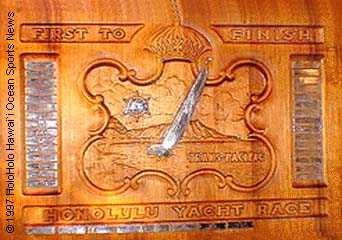
|

|

Long Beach, Calif (June 24, 1997) -- When the elite of the fleet in
the 39th Transpacific Yacht Race set off for Hawai`i on Saturday, July 5,
they'll not only be chasing a Pacific sunset but a strange trophy they
would sell their sailing souls for:  It's a 3 x 4 1/2-foot, 3 3/8-inch thick slab of Hawaiian koa wood officially named the Transpacific Yacht Club Perpetual Trophy but more commonly known for its unique proportions. Who carved it, who nicknamed it--indeed, which of three known versions is the original--remain a mystery. Although the West Coast's premier sailboat race dates to 1906, the Barn Door didn't appear until the late 40s, according to Bob Allan of Carmel, a competitor of the post-World War II era. When Allan raced on Bill Stewart's victorious Chubasco in 1947, he says, Chubasco won no Barn Door. "But in 1949 I was on Dick Rheem's Morning Star when we set a [then] record of 10 1/2 days--and we did get a 'Barn Door,' " Allan said. Rheem deposited what is believed to be a replica at the St. Francis Yacht Club in San Francisco, and in 1973 the widow of Frank Hooykaas, the winner aboard Barlovento in 1957, presented another to the Catalina Island Yacht Club, where it remains on display. All bear the prominent cutout words: "FIRST TO FINISH." That was appropriate until 1991 when organizers started staggering the starts to allow the smaller boats a head start and compress the first and last finishes at Diamond Head, which were sometimes a week or more apart. This year, in a race that normally takes two weeks or less, the seven boats in the new, more leisurely Cruising Division start June 28, a week ahead of the intensely contested maxi-sled class, and even the smaller, race-rigged monohulls were given a three-day head start on July 2. Multihulls, the fastest of all, start July 7. So when it evolved in '91 that the tradition of the fastest boat finishing first might change, the Barn Door's recipient officially became the monohull with the "fastest elapsed time," no matter what's carved in the upper left corner. If that takes an edge off the quest, it's not apparent by the entry list. There are nine boats going all-out in Division I, the top maxi-sled class. Five belong to the new generation of pure lightweight "turbo sleds" evolved from the stock ULDB 70 class: Hal Ward's defending champion Cheval; Roy Disney's Pyewacket; Mike Campbell's Victoria; Doug Baker's new Magnitude; and Anthony Sessions' Canadian entry Luna Barba, which was called Silver Bullet when former owner John DeLaura claimed the Barn Door in 1989 and '93. Others in Division I include three new boats: Vicki, the pride of Al Schultz and actress wife Vicki Lawrence; Dan Sinclair's Renegade from Canada, and the imposing and mysterious new Zephyrus IV. Finally, there is the venerable and reconfigured Merlin, whose record has stood for 20 years. Because Merlin won the Barn Door in 1977 and '87, as well as '81, co-skipper Skip Stevely says, "Going by decades, it's our time again." The boat still owns three of the four fastest elapsed times ever and in '95 was fifth fastest and corrected out first overall on handicap. The Lee 68, forerunner of the ULDB 70 "sled" class, was first sailed in '77 by designer Bill Lee to a record time of 8 days 11 hours 1 minute 45 seconds from Point Fermin to the Diamond Head buoy. Four years later a charter group led by Nick Frazee missed that time by 46 seconds, and since then potentially faster boats have been waiting for the fair winds that favored Merlin. One must finish within a couple of minutes of midnight PDT July 13 to claim the record. Merlin this time is chartered by the "Alliance Syndicate," which consists of Stevely of San Francisco and John Jacquemin and Art Santry of New York. Stevely has done 11 Transpacs, including five on Merlin. Stevely realizes Merlin's inherent shortcoming: Lee built it to sail downwind, not upwind. Sometimes, early in the race, Stevely said, "It's real depressing. But when we start surfing we go fast." Merlin has been modified with a canting keel that swings 10 or 11 degrees to either side for increased stability. That should help, but for the first couple of days of upwind sailing Merlin may still suffer until the tradewinds kick in from abeam. Long Beach's Alan Andrews has a major stake in the race. He designed Cheval, Victoria, Magnitude, Vicki and Renegade, as well as Persuasion and Medicine Man in Division III starting July 2. Zephyrus IV, designed by John Reichel and Jim Pugh for San Diego's John Parrish and San Francisco's Bob McNeil, has never raced. It's bigger than its rivals--75 feet and 30,000 pounds displacement to 68 1/2 feet and 26,000 for the turbos--and its crew includes North Sails president Gary Weisman. To avert an arms war, all boats must rate within the Transpac "speed limit" according to their speed potential, but Pugh said extra muscle was built into Zephyrus IV. "We're looking for more performance in the first third of the race when you're power-reaching," he said, "and we still hope to get the same performance downwind." In '95, Cheval outperformed two potentially more powerful boats--Sayonara and Windquest--to win the Barn Door, despite losing two-thirds of its mast and sailing under jury rig on the final day. Ward, an Arcadia eye surgeon, still basks in the glory. "First to finish in the Transpac is the Holy Grail of West Coast racing," he said.
Media Alert
Now there's betting!
For Mainland media information until July 12, please contact:
For daily position and standings excerpts phone:
Transpacific Yacht Club |

 WYC Transpac Nav Station
WYC Transpac Nav Station
Last modified July 4th '97 1949 Hawaiian Time
Copyright © 1997, HoloHolo Internet Publishing, all rights reserved